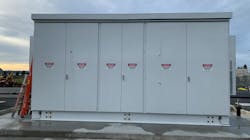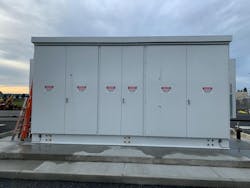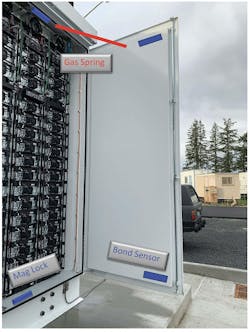A Simple Solution for Preventing Battery Cabinet Explosions
Stationary energy storage system (ESS) deployment has outpaced the development of codes and standards for safe and effective methods of preventing fires and explosions in the event of catastrophic damage. Although fewer than 50 significant ESS-related fires have occurred worldwide, there have already been two fatalities and four significant injuries of firefighters responding to these incidents — and the risk of explosions is seen by many in the industry as the primary gap in system design and published codes. Underwriters Laboratories conducted testing to evaluate explosion risks based and found that current standard fire suppression options do not address the flammable gases that may continue to be produced during thermal runaway.
Li-ion chemistries, the most common electrochemical technology for stationary ESS applications, present the greatest safety risks in the event of damage. Future chemistries are expected to address these risks, but available technologies are tightly regulated. The key codes include NFPA 855, Standard for Installation of Stationary Energy Storage Systems 2020 edition, and the International Fire Code 2021 edition. The key product safety standard addressing ESS is UL9540, which includes large-scale fire testing to UL 9540a. This standard covers the entire system of battery cells, associated battery management systems (BMS), power conversion equipment (PCS), environmental controls, communications, and assembly. It addresses the functional safety of the ESS and includes large-scale fire testing to inform adequate fire protection and explosion protection system designs.
As required by both NFPA 855 and the IFC, ESS must be listed to UL9540. Another requirement in NFPA 855 is for explosion controls. The options include either deflagration vents (blow-out panels) designed to NFPA 68, or a deflagration prevention system designed to NFPA 69. Both these options require a fire protection engineer to take the gas production data from cell-level and module-level fire testing to model either the required vent area needed to keep pressure waves below a design limit in the case of an explosion, or if a deflagration prevention system is the design option, ensure that flammable gases are maintained below 25% of the lower explosive limit (LEL). This last option has typically been achieved with a mechanical exhaust system.
These requirements are already affecting how systems are being designed by manufacturers, while trying to remain competitive in the face of significant development and deployment costs. For example, performing a destructive fire test is both time consuming and expensive. The ability to produce a listed ESS based on a modular enclosure format is expected to become more common. An enclosure that is designed to achieve the highest energy density will eliminate the interior access aisle in favor of exterior access doors. This is often described as a “cabinet” type enclosure, as opposed to a walk-in enclosure similar to some designs based on ISO shipping containers.
DOE Support
Pacific Northwest National Laboratory, one of 17 U.S. Department of Energy national laboratories, has electrical grid modernization as one of its research priorities. Work on ESS safety is a key area for PNNL’s Battery Materials & Systems Group. Funded by the Department of Energy’s Office of Electricity, PNNL has recently developed technology to prevent explosions in outdoor ESS enclosures. Aptly named IntelliVent, this system automatically opens exterior ESS cabinet doors early in a thermal runaway event. The patent-pending technology responds to existing smoke detectors incorporated into the ESS. Upon detection of smoke, the IntelliVent system operates electromagnetic door locks to release all doors simultaneously. Doors are then fully opened by gas springs to allow passive dilution of any flammable gas buildup. The system is based on a failsafe design that opens all doors at the loss of power; battery backup is incorporated, as are supervisory signals for door position and loss of line voltage or battery power.
Intellivent is designed for outdoor ESS cabinets, which have very small interior free air volumes due to the design of maximizing battery density in the enclosure. These small free air volumes make ensuring any flammable gas remains below 25% of the LEL a significant challenge. Opening all doors rapidly and early in a fire event not only reduces the risk of a deflagration, but also any subsequent pressure wave or fireball. Another key benefit is situational awareness; technicians or responders can see what is occurring in the enclosure from a safe distance. This is of prime interest to fire officials for two main reasons:
- The ability to safely see (from a distance) into an enclosure will support better decision-making for technicians and emergency responders.
- There is great concern about the duration of hazardous incidents. The ability to direct water (if needed) through an open door to directly affect incident termination is one of the benefits of IntelliVent.
Utility Partnering
The first installation of the IntelliVent system through a licensing agreement is with the Snohomish Public Utility District (SnoPUD) in Washington State. The installation is projected to be complete by September 2021. SnoPUD will retrofit a 1.2 MW ESS cabinet that is part of a microgrid demonstration project. The enclosure is a hybrid cabinet where all the battery modules are accessed from the exterior, but it also has interior access to the communications and controls equipment, clean agent, and fire alarm control panel. In discussions with fire officials, the inclusion of IntelliVent may eliminate the need for fixed water suppression systems (depending on the location of the ESS).
The system offers significant benefits for existing enclosures as a retrofit to respond to explosion concerns. The system will need to take into consideration door design, fire detection sensor design, and insulation of enclosure. Future work will focus on identifying the heat flux at a 6 ft distance obtained during the installation-level large-scale fire testing done as part of the product listing. This will provide data to determine what level of insulation is needed in the enclosure to protect nearby cabinets should one fail, with open doors exposing any fire conditions.
Summary
PNNL designed the IntelliVent system to address the risk of explosions in outdoor battery cabinets in an affordable, retrofittable, and reliable solution based on listed components. PNNL seeks to provide technology to support the ESS industry and believes this technology to offer options for ESS system designers to address one of the key safety gaps for fire events in ESS capable of thermal runaway.
About the Author
Matthew Paiss
Matthew Paiss serves as a technical advisor in the Battery Materials & Systems group at Pacific Northwest National Laboratory. Prior to joining PNNL, he was the president of Energy Response Solutions, Inc (a Training & Consultation firm). He brings 28 years of emergency response experience after retiring as a fire captain with the San Jose CA Fire Department.
Paiss’s background in renewable energy started in 1982 at ARCO Solar in Camarillo, CA before studying Solar Technology and Fire Science in Santa Cruz, CA. Matt has 10 years’ experience on RE Codes & Standards committees and currently serves on NFPA 855 Energy Storage Systems, UL Standards Technical Panels 9540, 1974, and IEC TC120. He served as a subject matter expert for the National Fire Protection Association on energy storage and has contributed to the model Fire Code sections on PV & ESS and has delivered electrical safety training to over 8000 firefighters nationwide and spoken across North America and in Europe on fire and PV/ESS safety.



